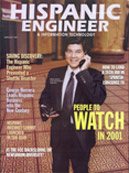 |
|
|
 Join the Hispanic Engineer mailing list!
| ||||||||||||||||||||||||||
|
The Top
Schools for Hispanics By Bruce E. Phillips What are the best schools for Hispanics who want to pursue a degree in engineering? One way to gauge "best" is to look at the numbers. For us, that means answering this fundamental question: Which schools are graduating the largest number of Hispanic students? The National Action Council for Minorities in Engineering, Inc. (NACME; http://www.nacme.org) has looked at minority graduation rates for institutions of higher education. Of the 21 universities in the continental U.S. that graduated the most Latino engineers in the class of 1996-97, six are designated as Hispanic-Serving Institutions (HSIs). HSIs are defined as colleges or universities with at least 25 percent Hispanic enrollment. About two-thirds of all Hispanic college students attend HSIs. The Hispanic Association of Colleges and Universities (HACU; http://www.hacu.net) has identified 209 HSIs in the continental U.S. and Puerto Rico, 41 of which offer bachelor's degrees in engineering or engineering-related technologies. According
to NACME's 1996-97 report, the six top HSIs in the
continental United States in number of Latino engineering
graduates were Florida International University (141
graduates), University of Texas - El Paso (105), New Mexico
State University (70), Texas A&M University - Kingsville
(63), the University of New Mexico (48), and University of
Texas - Pan American (44). When U.S. territories are
included in the calculations, the University of Puerto Rico-Mayaguez
and the Universidad Politécnica de Puerto Rico graduate by
far the largest number of Hispanic engineers. "Ours
is a five-year program, and because of this, we can give
students a broader education than other schools," Dr.
Calderon says. And, he adds, "industry is telling us
they appreciate this." "A large majority of the faculty is involved in research," Dr. Ferregut says. "Undergraduates as well as graduate students get to work closely with the faculty." This
gives students a chance to do their own research, he says:
"Undergraduates get the chance to write original papers
and present them at conferences." To
encourage interest in science and engineering studies, the
university has an active outreach program. Dean Jordan
explains: "We start with middle school students by
offering them a summer program to get them interested in
engineering. This helps them make the right choices in math
and science during high school." Dean
Compton says the faculty of Texas A&M
University-Kingsville recognize the value of "teaching
through research" and provide undergraduate students
the opportunity to become involved in a wide variety of
research projects. He stresses that the department's courses are always current, because they are built around a faculty that is on the cutting edge of research. Dean
Cecchi emphasizes that the university has "a strong
commitment to diversity in all dimensions" and offers
support programs to help enhance the graduation rate and
advancement of students. "Our
graduates are in demand by global businesses in part because
they are bilingual and bicultural," Dr. LeMaster says. To learn
more about opportunities in engineering, you may contact the
Hispanic Association of Colleges and Universities. The
Bureau of Labor Statistics publishes extensive career
information at their site, http://stats.bls.gov. We also
recommend reading "America's Best Colleges,"
published by U.S. News & World Report each year.
|
| HOME · EVENTS · ABOUT US |
|
Copyright © 2001. All rights reserved. |
